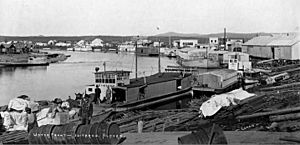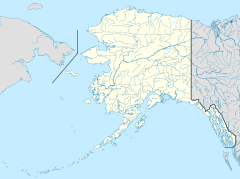Iditarod, Alaska facts for kids
Iditarod is an abandoned town in the Yukon-Koyukuk Census Area in the U.S. state of Alaska. It is currently part of the Flat Census Designated Place, which also has no residents. A ghost town is a place where almost everyone has left, and it's mostly empty now.
Quick facts for kids
Iditarod
|
|
|---|---|

Port of Iditarod, around 1911
|
|
| Country | United States |
| State | Alaska |
| Census area | Yukon-Koyukuk |
| Time zone | UTC-9 (Alaska (AKST)) |
| • Summer (DST) | UTC-8 (AKDT) |
Contents
History of Iditarod: A Gold Rush Town
The town of Iditarod got its name from the Iditarod River. The word Iditarod comes from the Athabascan word Haidilatna.
Gold Discovery and Early Days
On Christmas Day in 1908, two prospectors named John Beaton and W.A. "Bill" Dikeman found gold. They found it on Otter Creek, which flows into the Iditarod River. When news of this gold discovery spread, many miners arrived in the summer of 1909. They built a small camp that later became known as Flat.
People and supplies traveled to these gold fields by boat. They came from the Yukon River, went up the Innoko River, and then up the Iditarod River. The town site was just a short walk from Flat.
Iditarod's Boomtown Years
More gold was found, leading to a huge rush of people heading to Flat in 1910. The steamboat Tanana arrived on June 1, 1910. This marked the official founding of the city of Iditarod. It became the main port for all the nearby gold fields, including Flat, Discovery, Otter, Dikeman, and Willow Creek.
Iditarod quickly grew into a busy boomtown. It had hotels, cafés, and even three newspapers, though only one lasted. There was a Miners and Merchants Bank, a large store, electricity, and telephones. They even had cars and a small train line that went to Flat.
The Decline of Iditarod
By 1930, most of the gold was gone. Many miners moved to Flat, taking their buildings with them. Iditarod then became a ghost town. Today, only one old cabin and a few ruins are left. You can still see the concrete bank vault from the Miners and Merchants Bank, but the bank building itself is gone.
Population Changes in Iditarod
| Historical population | |||
|---|---|---|---|
| Census | Pop. | %± | |
| 1920 | 50 | — | |
| 1930 | 8 | −84.0% | |
| 1940 | 1 | −87.5% | |
| 2010 | 0 | — | |
Iditarod first appeared in the U.S. Census in 1920. At that time, it was an official city with 50 residents. This was after the biggest gold rush had already ended. In 1931, the city was no longer officially recognized. By 1940, only one person lived there.
After 1940, Iditarod was not listed separately in the census. However, the area was included in the census place called Flat starting in 2000. But even Flat's remaining residents left, so the population of the entire area is now zero.
Where is Iditarod Located?
Iditarod is located in the Yukon-Koyukuk Census Area in Alaska. This area is in the western part of the state. It is a remote location, meaning it is far from other towns and cities.


